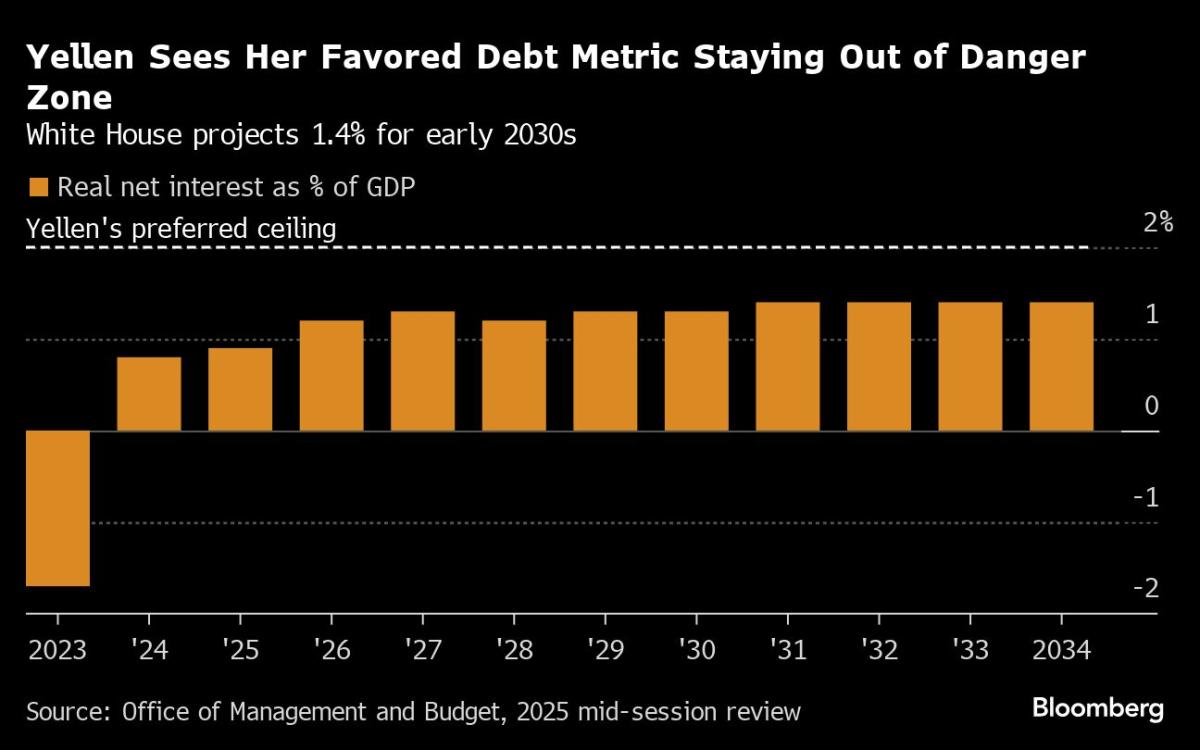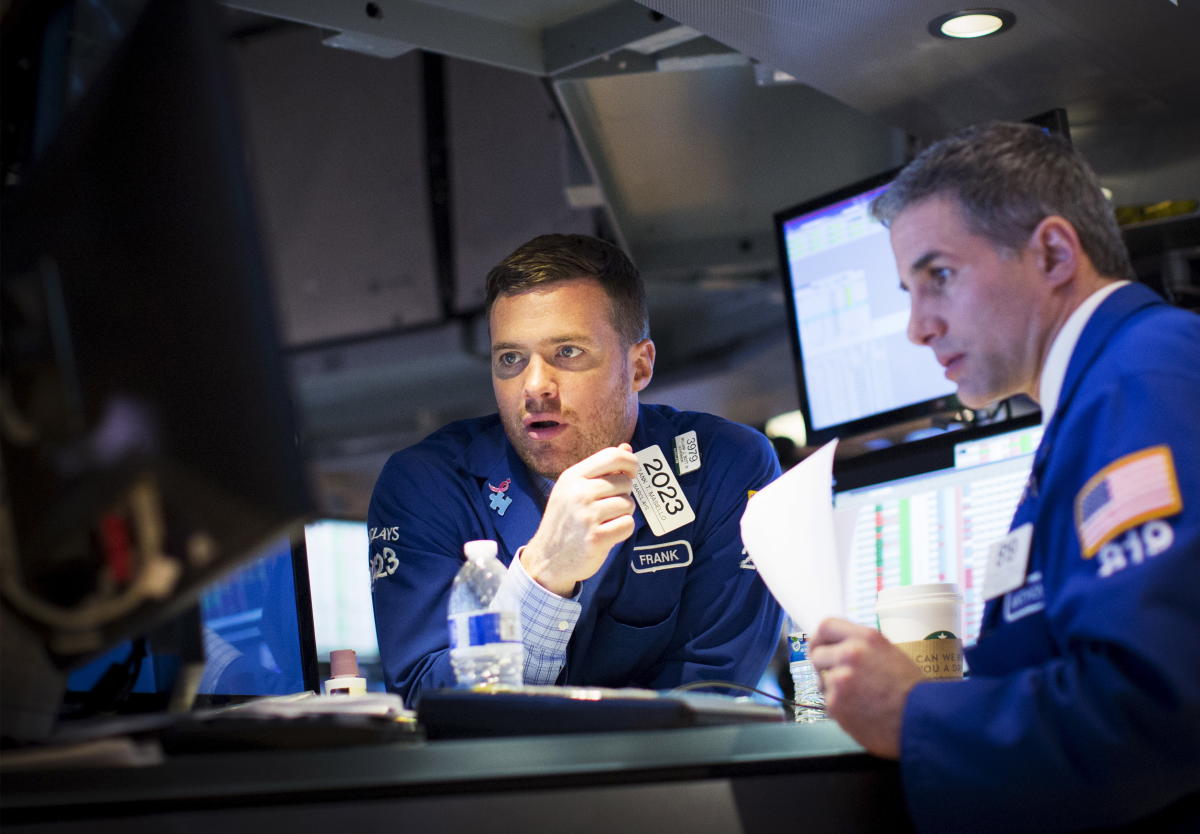CryptoCurrency
US Interest Burden Hits 28-Year High, Escalating Political Risk

(Bloomberg) — The US debt interest-cost burden climbed to the highest since the 1990s in the financial year that’s just ended, escalating the risk that fiscal worries limit the policy options for the next administration in Washington.
Most Read from Bloomberg
The Treasury spent $882 billion on net interest payments in the fiscal year through September — an average of roughly $2.4 billion a day, according to data the department released Friday. The cost was the equivalent of 3.06% as a share of gross domestic product, the highest ratio since 1996.
Historically high budget deficits, which caused total debt outstanding to soar in recent years, are a key reason for the increase. Those deficits reflect a steady rise in spending on Social Security and Medicare, as well as the extraordinary spending the US unleashed to battle Covid and constraints on revenue from sweeping 2017 tax cuts. Another big driver: the inflation-driven surge in interest rates.
“The higher interest costs are, the more politically salient these issues are,” said Wendy Edelberg, director of the Brookings Institution’s Hamilton Project. It raises the chance of politicians recognizing that “funding our spending priorities through borrowing is not costless,” she said.
While neither former President Donald Trump nor Vice President Kamala Harris has made deficit reduction a central element of their campaign, the debt issue looms over the next administration nonetheless. With Congress heading for a narrow partisan split, it could only take a handful, or potentially lone, deficit-wary legislator to stymie tax and spending plans.
That scenario was already seen in the outgoing Biden administration, when then-Democrat Joe Manchin forced a scaling back of spending items the White House favored as the price for passing signature legislative packages in 2021 and 2022.
Even if Republicans take control of both chambers, and Trump takes the White House, the likely narrowness of the majority could leave GOP fiscal hawks with the power to demand changes to sweeping tax cuts.
“It would just be remarkable if what came out of the tax debate next year was a whole group of policymakers looking at our debt trajectory and deciding just to make it worse,” said Edelberg, a former chief economist at the Congressional Budget Office.
The net interest bill exceeded the Defense Department’s spending on military programs for the first time, according to data from the Treasury Department and the Office of Management and Budget. It also amounted to about 18% of federal revenues — almost double the ratio from two years ago.
The Federal Reserve’s shift to lowering rates is offering some relief to the Treasury. The weighted average interest on outstanding US debt was 3.32% at the end of September, marking the first monthly decline in nearly three years.
Even so, the scale of the interest costs is now so large that they are by themselves adding to the overall debt load held by the public, which stands at $27.7 trillion — approaching 100% of GDP. Debt servicing was among the fastest growing parts of the budget last year. Spending on interest also risks weighing on economic growth by crowding out private investment.
The nonpartisan CBO estimates that every additional dollar of deficit-financed spending reduces private investment by 33 cents.
“From a variety of standpoints, the fact that the interest costs are growing the debt and causing other economic ramifications is a problem for our economy,” said Shai Akabas, executive director of the Bipartisan Policy Center’s Economic Policy Program.
Treasury Secretary Janet Yellen has played down concerns, saying that the key metric to track in assessing US fiscal sustainability is inflation-adjusted interest payments compared with GDP. That ratio has jumped the past year, but the White House sees it stabilizing at about 1.3% over the coming decade. Yellen has said it’s important to stay below 2%, a level seen by some as a key threshold for sustainability.
The White House projections, however, assume passage of revenue-raising measures that the outgoing Biden administration proposed. Harris, too, has called for raising taxes on the wealthiest Americans and on corporations.
Trump says the key to addressing the fiscal outlook is yet more tax cuts, which he argues will boost economic growth, offsetting the hit to the government’s bottom line.
Most economists see debt continuing to climb under either candidate. The Committee for a Responsible Federal Budget estimates the Harris economic plan would increase the debt by $3.5 trillion over a decade, while Trump’s would sending it soaring by $7.5 trillion.
Besides the election outcome, the magnitude of Fed rate cuts will affect the fiscal outlook. While rate hikes were quickly reflected in the Treasury’s interest bill after policymakers kicked them off in March 2022, rate cuts may take more time to bring down the government’s borrowing costs.
That’s in part because a swath of the US debt maturing in coming years carries particularly low rates, which preceded the Fed’s tightening cycle. Many securities will be replaced by Treasuries that will be costlier to service. And that may prove to be the case for years to come — especially if the Fed halts rate cuts at a higher level than pre-Covid. The Fed’s short-term benchmark rate averaged less than 0.75% over the decade through 2019; policymakers in September projected the rate would settle around 2.9% in time.
In the meantime, costs tied to Social Security and Medicare will keep rising as the US population ages, contributing to outsize budget deficits for decades ahead unless reforms are made. That pressure, and an aversion of politicians to take on changing the popular programs, has put pressure on the remaining areas of federal spending, known as discretionary.
Back in the 1960s, discretionary spending made up about 70% of the federal total, but now the ratio is just 30%, according to analysis by Torsten Slok, chief economist at Apollo Global Management.
For now, investors are showing little sign of concern about US fiscal challenges, with the Fed’s easing cycle and concerns about a weakening job market continuing to support demand for Treasuries. But if and when they do, that could prove decisive for Washington, said Gary Schlossberg, global strategist at Wells Fargo Investment Institute.
“The landscape has changed,” Schlossberg said. “Before, we had more of a free ride — with rates low. You could run up the debt and it didn’t really show up much in interest expenses. That’s obviously not there now.”
–With assistance from Ben Holland and Liz Capo McCormick.
Most Read from Bloomberg Businessweek
©2024 Bloomberg L.P.
CryptoCurrency
Nasdaq, S&P 500 sink as tech leads losses ahead of Tesla earnings

Sales of existing homes fell in September as house hunters remained on the fence about buying a home despite mortgage rates easing during the month.
Existing home sales slipped 1.0% from August’s tally to a seasonally adjusted annual rate of 3.84 million, the National Association of Realtors said Wednesday. That marked the lowest rate since October 2010. Economists polled by Bloomberg expected a pace of 3.88 million in September.
On a yearly basis, sales of previously owned homes were 3.5% lower in September. The median home price rose 3.0% from last September to $404,500, marking the 15th consecutive month of annual price increases.
“Home sales have been essentially stuck at around a 4 million-unit pace for the past 12 months,” NAR chief economist Lawrence Yun said in a press release.
There have been significant challenges that have weighed on sales activity, including a lack of inventory, escalating prices, and elevated mortgage rates. Last month, however, those factors turned around.
The Federal Reserve cut its benchmark rate by half a percentage point in September. While the central bank doesn’t set mortgage rates, its actions influence their direction of movement.
Mortgage rates hit the lowest level since February 2023 ahead of the Fed decision to ease, while listing inventory picked up.
But overall, that hasn’t been enough to entice buyers.
“Some consumers are hesitating about moving forward with a major expenditure like purchasing a home before the upcoming election,” Yun said.
CryptoCurrency
Tesla stock jumps on Q3 earnings beat

Tesla (TSLA) reported mixed third quarter results after the bell on Wednesday, but the stock jumped in after-hours trading as investors cheered the earnings beat, higher gross margins, and news that Tesla’s cheaper EV is on track for production next year.
For the quarter, Tesla reported revenue of $25.18 billion vs. $25.4 billion per Bloomberg consensus, higher than the $25.05 billion it reported in Q2 and also topping the $23.40 billion Tesla reported a year ago. Tesla posted adjusted EPS of $0.72 vs $0.60 expected, on adjusted net income of $2.5 billion and free cash flow of $2.9 billion.
The closely watched gross margin figure came in at 19.8%, much higher than the 16.8% expected.
Tesla shares were up nearly 8% in after hours trade.
“We delivered strong results in Q3 with growth in vehicle deliveries both sequentially and year-on-year, resulting in record third-quarter volumes,” the company said in its earnings deck. “Preparations remain underway for our offering of new vehicles — including more affordable models — which we will begin launching in the first half of 2025.”
Earlier this month, Tesla (TSLA) announced third quarter deliveries that slightly missed expectations, sending the stock lower.
Tesla said it delivered 462,890 vehicles in Q3, up 6.4% quarter over quarter, to mark the first quarter of delivery growth this year. The numbers also came in ahead of the 435,059 EVs the company delivered in the year-ago period. But Wall Street had expected Tesla to deliver closer to 463,897, according to Bloomberg.
“Refreshed Model 3 ramp continued successfully in Q3 with higher total production and lower cost of goods sold quarter-over-quarter. Cybertruck production increased sequentially and achieved a positive gross margin for the first time,” Tesla said in its report.
Tesla said it expects vehicle deliveries to achieve “slight growth” in 2024.
Ahead of Tesla’s Q3 disclosure, shares were down approximately 11% since Tesla revealed its robotaxi, dubbed the Cybercab, at its showy “We, Robot” event from the Warner Bros. studio lot in Burbank, Calif., on Oct. 10.
The debut and release of a cheaper EV is what many analysts and industry watchers believe will spur the next leg higher of EV sales, as even CEO Elon Musk has said before. During its Q2 report, Tesla and Musk said the company remains on track for the production of new vehicles, likely including a cheaper EV, in the first half of next year.
Investors and analysts were left wanting more details from Tesla’s “We, Robot” event on the Cybercab itself and detailed testing plans, along with questions about the development of Tesla’s sub-$30,000 EV, dubbed the Model 2.
CryptoCurrency
Transak hit by data breach, 92K users exposed


Transak disclosed a data breach affecting over 92,000 users after a phishing attack compromised an employee’s laptop.
CryptoCurrency
The Dow plummets more than 600 points and is on track for its worst day in more than a month

The Dow Jones Industrial Average and other major indexes suffered a steep decline Wednesday afternoon as the yield on the benchmark 10-year U.S. Treasury note continued its upward climb, reaching 4.23%—a level not seen since July.
In the afternoon, the Dow dropped 631 points, or 1.4%, heading for its worst day in over a month. Meanwhile, the tech-heavy Nasdaq and the S&P 500 declined by 2.2% and 1.4%, respectively. However, there was some relief for investors as oil prices eased, with West Texas Intermediate (WTI) futures trading around $70.65 per barrel.
The Federal Reserve’s Beige Book, released in the afternoon, reported that economic activity remained largely unchanged across the 12 Federal Reserve Districts, with the Southeast significantly impacted by a harsh storm season.
On Wednesday, all eyes are on Tesla (TSLA) as the company prepares to release its latest earnings report. Analysts expect earnings per share to be 60 cents, down from 66 cents a year ago but an improvement from 52 cents in the previous quarter, according to FactSet estimates. Revenue is projected to hit $25.4 billion, compared to $23.3 billion in the third quarter of 2023 and $25.5 billion in the preceding quarter.
Apart from Tesla, investors are closely monitoring earnings reports from other major corporations, including AT&T (T), Boeing (BA), and Coca-Cola (KO).
McDonald’s stock plunges over 5%
McDonald’s (MCD) shares took a sharp hit, falling over 5% after the Centers for Disease Control and Prevention (CDC) linked the chain’s Quarter Pounder burgers to an E. coli outbreak. The outbreak has led to 10 hospitalizations and one death, driving a significant decline in McDonald’s stock during the afternoon trading session.
As of now, 49 cases have been reported across 10 states between Sept. 27 and Oct. 11, with a majority of illnesses occurring in Colorado, Nebraska, Utah, and Wyoming. The CDC noted that most of those affected had eaten a Quarter Pounder. Investigators are working swiftly to identify the contaminated ingredient.
Spirit Airlines stock soars 30%
After a failed attempt at merging with JetBlue (JBLU-0.80%), ultra-low-cost carrier Spirit Airlines (SAVE+28.01%) is reportedly turning back to a familiar partner. The Wall Street Journal (NWSA-0.34%), citing people familiar with the matter, reports that Spirit and Frontier Airlines (ULCC+3.05%) are in early talks over a potential merger. The news sent Spirit’s stock soaring nearly 30% on Wednesday.
–Francisco Velasquez and Rocio Fabbro contributed to the article
CryptoCurrency
Zanzibar’s new blockchain sandbox aims to drive tech startup growth


The semi-autonomous region of Tanzania is taking advantage of a sandbox regulatory framework adopted in July.
CryptoCurrency
Price analysis 10/23: BTC, ETH, BNB, SOL, XRP, DOGE, TON, ADA, AVAX, SHIB


Bitcoin’s correction ignited selling in altcoins, which are slipping below critical support levels.
-

 Science & Environment1 month ago
Science & Environment1 month agoHyperelastic gel is one of the stretchiest materials known to science
-

 Technology4 weeks ago
Technology4 weeks agoIs sharing your smartphone PIN part of a healthy relationship?
-

 Science & Environment1 month ago
Science & Environment1 month ago‘Running of the bulls’ festival crowds move like charged particles
-

 Science & Environment1 month ago
Science & Environment1 month agoMaxwell’s demon charges quantum batteries inside of a quantum computer
-

 Science & Environment1 month ago
Science & Environment1 month agoHow to unsnarl a tangle of threads, according to physics
-

 Science & Environment4 weeks ago
Science & Environment4 weeks agoX-rays reveal half-billion-year-old insect ancestor
-

 Technology1 month ago
Technology1 month agoWould-be reality TV contestants ‘not looking real’
-

 Science & Environment1 month ago
Science & Environment1 month agoSunlight-trapping device can generate temperatures over 1000°C
-

 Science & Environment1 month ago
Science & Environment1 month agoLiquid crystals could improve quantum communication devices
-

 Science & Environment1 month ago
Science & Environment1 month agoQuantum ‘supersolid’ matter stirred using magnets
-

 Technology3 weeks ago
Technology3 weeks agoUkraine is using AI to manage the removal of Russian landmines
-

 Womens Workouts1 month ago
Womens Workouts1 month ago3 Day Full Body Women’s Dumbbell Only Workout
-

 TV3 weeks ago
TV3 weeks agoসারাদেশে দিনব্যাপী বৃষ্টির পূর্বাভাস; সমুদ্রবন্দরে ৩ নম্বর সংকেত | Weather Today | Jamuna TV
-

 Science & Environment1 month ago
Science & Environment1 month agoLaser helps turn an electron into a coil of mass and charge
-

 Science & Environment1 month ago
Science & Environment1 month agoWhy this is a golden age for life to thrive across the universe
-

 Science & Environment1 month ago
Science & Environment1 month agoA new kind of experiment at the Large Hadron Collider could unravel quantum reality
-

 Science & Environment1 month ago
Science & Environment1 month agoQuantum forces used to automatically assemble tiny device
-

 News3 weeks ago
News3 weeks agoMassive blasts in Beirut after renewed Israeli air strikes
-

 Football3 weeks ago
Football3 weeks agoRangers & Celtic ready for first SWPL derby showdown
-

 News3 weeks ago
News3 weeks ago▶ Hamas Spent $1B on Tunnels Instead of Investing in a Future for Gaza’s People
-

 News3 weeks ago
News3 weeks agoNavigating the News Void: Opportunities for Revitalization
-

 Business3 weeks ago
Business3 weeks agoWhen to tip and when not to tip
-

 Science & Environment1 month ago
Science & Environment1 month agoA slight curve helps rocks make the biggest splash
-

 Science & Environment1 month ago
Science & Environment1 month agoNerve fibres in the brain could generate quantum entanglement
-

 Science & Environment1 month ago
Science & Environment1 month agoHow to wrap your mind around the real multiverse
-

 Technology3 weeks ago
Technology3 weeks agoMicrophone made of atom-thick graphene could be used in smartphones
-

 Technology3 weeks ago
Technology3 weeks agoSamsung Passkeys will work with Samsung’s smart home devices
-

 MMA2 weeks ago
MMA2 weeks ago‘Uncrowned queen’ Kayla Harrison tastes blood, wants UFC title run
-

 MMA3 weeks ago
MMA3 weeks agoJulianna Peña trashes Raquel Pennington’s behavior as champ
-
Business3 weeks ago
DoJ accuses Donald Trump of ‘private criminal effort’ to overturn 2020 election
-

 MMA3 weeks ago
MMA3 weeks agoPereira vs. Rountree prediction: Champ chases legend status
-

 Science & Environment1 month ago
Science & Environment1 month agoITER: Is the world’s biggest fusion experiment dead after new delay to 2035?
-

 Science & Environment1 month ago
Science & Environment1 month agoNuclear fusion experiment overcomes two key operating hurdles
-

 News1 month ago
News1 month ago▶️ Hamas in the West Bank: Rising Support and Deadly Attacks You Might Not Know About
-

 Science & Environment1 month ago
Science & Environment1 month agoPhysicists have worked out how to melt any material
-

 News1 month ago
News1 month ago▶️ Media Bias: How They Spin Attack on Hezbollah and Ignore the Reality
-

 Sport3 weeks ago
Sport3 weeks agoWales fall to second loss of WXV against Italy
-

 Sport3 weeks ago
Sport3 weeks agoMan City ask for Premier League season to be DELAYED as Pep Guardiola escalates fixture pile-up row
-

 Science & Environment1 month ago
Science & Environment1 month agoTime travel sci-fi novel is a rip-roaringly good thought experiment
-

 Technology1 month ago
Technology1 month agoMeta has a major opportunity to win the AI hardware race
-

 Technology4 weeks ago
Technology4 weeks agoWhy Machines Learn: A clever primer makes sense of what makes AI possible
-
News1 month ago
the pick of new debut fiction
-

 News1 month ago
News1 month agoOur millionaire neighbour blocks us from using public footpath & screams at us in street.. it’s like living in a WARZONE – WordupNews
-

 MMA3 weeks ago
MMA3 weeks agoDana White’s Contender Series 74 recap, analysis, winner grades
-

 Technology3 weeks ago
Technology3 weeks agoThis AI video generator can melt, crush, blow up, or turn anything into cake
-

 Technology3 weeks ago
Technology3 weeks agoMusk faces SEC questions over X takeover
-

 News3 weeks ago
News3 weeks agoFamily plans to honor hurricane victim using logs from fallen tree that killed him
-

 Sport3 weeks ago
Sport3 weeks agoBoxing: World champion Nick Ball set for Liverpool homecoming against Ronny Rios
-

 Technology3 weeks ago
Technology3 weeks agoThe best budget robot vacuums for 2024
-

 Sport3 weeks ago
Sport3 weeks agoWorld’s sexiest referee Claudia Romani shows off incredible figure in animal print bikini on South Beach
-

 News3 weeks ago
News3 weeks ago‘Blacks for Trump’ and Pennsylvania progressives play for undecided voters
-

 MMA3 weeks ago
MMA3 weeks agoPereira vs. Rountree preview show live stream
-
Business3 weeks ago
Sterling slides after Bailey says BoE could be ‘a bit more aggressive’ on rates
-

 Sport3 weeks ago
Sport3 weeks agoChina Open: Carlos Alcaraz recovers to beat Jannik Sinner in dramatic final
-

 News3 weeks ago
News3 weeks agoGerman Car Company Declares Bankruptcy – 200 Employees Lose Their Jobs
-

 Sport3 weeks ago
Sport3 weeks agoSturm Graz: How Austrians ended Red Bull’s title dominance
-

 MMA3 weeks ago
MMA3 weeks agoUFC 307 preview show: Will Alex Pereira’s wild ride continue, or does Khalil Rountree shock the world?
-

 TV3 weeks ago
TV3 weeks agoLove Island star sparks feud rumours as one Islander is missing from glam girls’ night
-

 Sport3 weeks ago
Sport3 weeks agoCoco Gauff stages superb comeback to reach China Open final
-
Business3 weeks ago
Bank of England warns of ‘future stress’ from hedge fund bets against US Treasuries
-

 Business3 weeks ago
Business3 weeks agoChancellor Rachel Reeves says she needs to raise £20bn. How might she do it?
-

 Technology3 weeks ago
Technology3 weeks agoMicrosoft just dropped Drasi, and it could change how we handle big data
-

 Technology3 weeks ago
Technology3 weeks agoTexas is suing TikTok for allegedly violating its new child privacy law
-

 Money3 weeks ago
Money3 weeks agoWetherspoons issues update on closures – see the full list of five still at risk and 26 gone for good
-

 Technology3 weeks ago
Technology3 weeks agoThe best shows on Max (formerly HBO Max) right now
-

 News3 weeks ago
News3 weeks agoHeavy strikes shake Beirut as Israel expands Lebanon campaign
-

 MMA3 weeks ago
MMA3 weeks agoAlex Pereira faces ‘trap game’ vs. Khalil Rountree
-

 Technology3 weeks ago
Technology3 weeks agoJ.B. Hunt and UP.Labs launch venture lab to build logistics startups
-

 TV3 weeks ago
TV3 weeks agoPhillip Schofield accidentally sets his camp on FIRE after using emergency radio to Channel 5 crew
-

 Technology3 weeks ago
Technology3 weeks agoGmail gets redesigned summary cards with more data & features
-

 News3 weeks ago
News3 weeks agoHeartbreaking end to search as body of influencer, 27, found after yacht party shipwreck on ‘Devil’s Throat’ coastline
-
Business3 weeks ago
Head of UK Competition Appeal Tribunal to step down after rebuke for serious misconduct
-

 Business3 weeks ago
Business3 weeks agoStark difference in UK and Ireland’s budgets
-

 Sport3 weeks ago
Sport3 weeks agoAaron Ramsdale: Southampton goalkeeper left Arsenal for more game time
-

 Entertainment3 weeks ago
Entertainment3 weeks agoNew documentary explores actor Christopher Reeve’s life and legacy
-

 Science & Environment1 month ago
Science & Environment1 month agoPhysicists are grappling with their own reproducibility crisis
-

 Football3 weeks ago
Football3 weeks agoSimo Valakari: New St Johnstone boss says Scotland special in his heart
-

 News3 weeks ago
News3 weeks agoWoman who died of cancer ‘was misdiagnosed on phone call with GP’
-

 News3 weeks ago
News3 weeks agoHull KR 10-8 Warrington Wolves – Robins reach first Super League Grand Final
-
Business3 weeks ago
The search for Japan’s ‘lost’ art
-

 Technology3 weeks ago
Technology3 weeks agoHow to disable Google Assistant on your Pixel Watch 3
-

 MMA3 weeks ago
MMA3 weeks agoKetlen Vieira vs. Kayla Harrison pick, start time, odds: UFC 307
-

 Entertainment3 weeks ago
Entertainment3 weeks ago“Golden owl” treasure hunt launched decades ago may finally have been solved
-

 Technology3 weeks ago
Technology3 weeks agoEpic Games CEO Tim Sweeney renews blast at ‘gatekeeper’ platform owners
-

 Science & Environment3 weeks ago
Science & Environment3 weeks agoMarkets watch for dangers of further escalation
-

 Football3 weeks ago
Football3 weeks agoWhy does Prince William support Aston Villa?
-

 Technology3 weeks ago
Technology3 weeks agoApple iPhone 16 Plus vs Samsung Galaxy S24+
-

 TV3 weeks ago
TV3 weeks agoMaayavi (මායාවී) | Episode 23 | 02nd October 2024 | Sirasa TV
-

 Technology3 weeks ago
Technology3 weeks agoPopular financial newsletter claims Roblox enables child sexual abuse
-

 Technology3 weeks ago
Technology3 weeks agoOpenAI secured more billions, but there’s still capital left for other startups
-

 Health & fitness3 weeks ago
Health & fitness3 weeks agoNHS surgeon who couldn’t find his scalpel cut patient’s chest open with the penknife he used to slice up his lunch
-

 Money3 weeks ago
Money3 weeks agoPub selling Britain’s ‘CHEAPEST’ pints for just £2.60 – but you’ll have to follow super-strict rules to get in
-

 News3 weeks ago
News3 weeks agoBalancing India and China Is the Challenge for Sri Lanka’s Dissanayake
-

 Science & Environment1 month ago
Science & Environment1 month agoA tale of two mysteries: ghostly neutrinos and the proton decay puzzle
-
Business4 weeks ago
Eurosceptic Andrej Babiš eyes return to power in Czech Republic
-

 Technology3 weeks ago
Technology3 weeks agoUniversity examiners fail to spot ChatGPT answers in real-world test
-

 Sport1 month ago
Sport1 month agoJoshua vs Dubois: Chris Eubank Jr says ‘AJ’ could beat Tyson Fury and any other heavyweight in the world
-
News1 month ago
The Project Censored Newsletter – May 2024
-

 Technology4 weeks ago
Technology4 weeks agoArtificial flavours released by cooking aim to improve lab-grown meat
-

 MMA3 weeks ago
MMA3 weeks agoHow to watch Salt Lake City title fights, lineup, odds, more

You must be logged in to post a comment Login